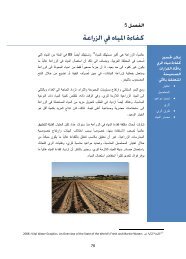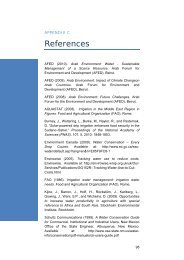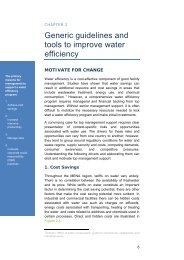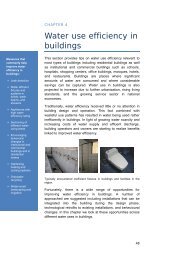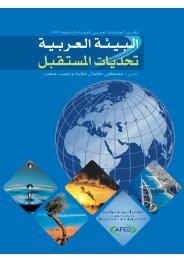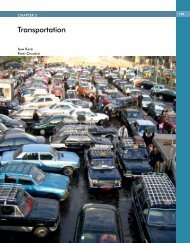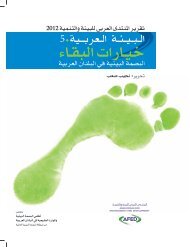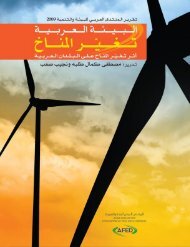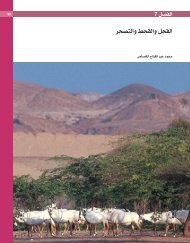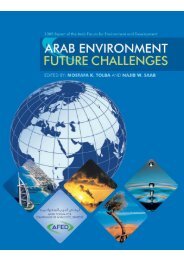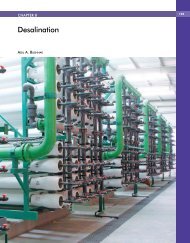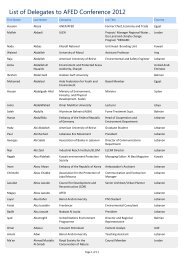Impact of Climate Change on Arab Countries - (IPCC) - Working ...
Impact of Climate Change on Arab Countries - (IPCC) - Working ...
Impact of Climate Change on Arab Countries - (IPCC) - Working ...
You also want an ePaper? Increase the reach of your titles
YUMPU automatically turns print PDFs into web optimized ePapers that Google loves.
122<br />
CHAPTER 10<br />
TOURISM<br />
(Milli<strong>on</strong>s)<br />
FIGURE 1<br />
40<br />
35<br />
30<br />
25<br />
20<br />
15<br />
10<br />
5<br />
0<br />
Source. U.N.W.T.O, 2008<br />
I. INTRODUCTION<br />
Tourism in the <strong>Arab</strong> world is becoming increasingly<br />
important given the natural, cultural and<br />
historic tourism potential <str<strong>on</strong>g>of</str<strong>on</strong>g> the regi<strong>on</strong>’s countries.<br />
Tourism can be c<strong>on</strong>sidered as a driving<br />
force for local ec<strong>on</strong>omies and a source <str<strong>on</strong>g>of</str<strong>on</strong>g> foreign<br />
currency, particularly for countries whose energy<br />
resources are limited such as Morocco, Tunisia<br />
and Leban<strong>on</strong>. Tourism could also be a lasting<br />
substitute for those countries that have<br />
ec<strong>on</strong>omies based <strong>on</strong> n<strong>on</strong>-renewable energy<br />
resources. However, like most other sectors <str<strong>on</strong>g>of</str<strong>on</strong>g><br />
ec<strong>on</strong>omic activity, the tourism sector is vulnerable<br />
to climate change impacts and might also<br />
c<strong>on</strong>tribute to or exacerbate it.<br />
In fact, tourism is regarded as <strong>on</strong>e <str<strong>on</strong>g>of</str<strong>on</strong>g> the ec<strong>on</strong>omic<br />
sectors most sensitive to the potential impacts <str<strong>on</strong>g>of</str<strong>on</strong>g><br />
climate change, as are the agricultural, envir<strong>on</strong>ment<br />
and water sectors (Wilbanks et al., 2007).<br />
This chapter highlights some issues related to<br />
tourism and climate change in the <strong>Arab</strong> world,<br />
and how these might impact these countries’<br />
ec<strong>on</strong>omies. It also suggests some mitigative and<br />
adaptative acti<strong>on</strong>s which need to be taken either<br />
in the short, medium and l<strong>on</strong>g term, to lessen the<br />
vulnerability <str<strong>on</strong>g>of</str<strong>on</strong>g> this sector.<br />
II. TOURISM IN THE ARAB WORLD<br />
According to statistics compiled by the World<br />
Tourism Organizati<strong>on</strong> (2008), internati<strong>on</strong>al<br />
tourist arrivals at the borders <str<strong>on</strong>g>of</str<strong>on</strong>g> the <strong>Arab</strong> countries<br />
in 1995, 2000, and 2005 were as depicted in<br />
Figures 1 and 2.<br />
TOURIST ARRIVALS IN THE ARAB WORLD<br />
1995 2000 2005<br />
Five <strong>Arab</strong> countries are am<strong>on</strong>g the top 50 most<br />
visited countries in the world. Saudi <strong>Arab</strong>ia is<br />
ranked 21 st , followed by Egypt (23 rd ) and<br />
Morocco (31 st ). Tunisia occupies the 34 th positi<strong>on</strong><br />
and Bahrain the 45 th positi<strong>on</strong>. As Saudi<br />
<strong>Arab</strong>ia is ranked the first destinati<strong>on</strong> in the <strong>Arab</strong><br />
regi<strong>on</strong>, we have to clarify that the visitors to<br />
Saudi <strong>Arab</strong>ia are almost exclusively pilgrims.<br />
Figures from the World Tourism Organizati<strong>on</strong><br />
<strong>on</strong> the evoluti<strong>on</strong> <str<strong>on</strong>g>of</str<strong>on</strong>g> internati<strong>on</strong>al tourism receipts<br />
in the <strong>Arab</strong> countries are given in Table 1.<br />
Five <strong>Arab</strong> countries are also am<strong>on</strong>g the top 50 in<br />
terms <str<strong>on</strong>g>of</str<strong>on</strong>g> tourism receipts. The first am<strong>on</strong>g them<br />
is Egypt which occupies the 27 th positi<strong>on</strong>, followed<br />
by Morocco (31 st ) and Saudi <strong>Arab</strong>ia<br />
(38 th ). Leban<strong>on</strong> ranked 41 st and the UAE occupies<br />
the 42 nd positi<strong>on</strong>.<br />
III. THE TOURISM SECTOR AND THE<br />
CHALLENGE OF CLIMATE CHANGE<br />
The relati<strong>on</strong>ship between tourism and climate<br />
has been studied for a l<strong>on</strong>g time, but it is very<br />
complex and remains difficult to define. The<br />
interest in the c<strong>on</strong>necti<strong>on</strong> between tourism and<br />
climate change is quite new in the literature, but<br />
has been getting special attenti<strong>on</strong> in the last two<br />
decades, as the sector is simultaneously very vulnerable<br />
to climate change and is am<strong>on</strong>g the<br />
major sources <str<strong>on</strong>g>of</str<strong>on</strong>g> greenhouse gas (GHG) emissi<strong>on</strong>s.<br />
This duality refers <strong>on</strong> <strong>on</strong>e side to the mitigati<strong>on</strong><br />
challenge and <strong>on</strong> the other side to vulnerability<br />
and adaptati<strong>on</strong> issues.<br />
The climate is a fundamental attribute <str<strong>on</strong>g>of</str<strong>on</strong>g> a<br />
tourism destinati<strong>on</strong>. It is a str<strong>on</strong>g factor <str<strong>on</strong>g>of</str<strong>on</strong>g> motivati<strong>on</strong><br />
and satisfacti<strong>on</strong>. However, the relati<strong>on</strong>ship<br />
between climate and tourism is very complex:<br />
the percepti<strong>on</strong> <str<strong>on</strong>g>of</str<strong>on</strong>g> what c<strong>on</strong>stitutes ìgood<br />
weather’ depends am<strong>on</strong>g others factors <strong>on</strong> the<br />
destinati<strong>on</strong>, the type <str<strong>on</strong>g>of</str<strong>on</strong>g> activity envisaged, and<br />
the tourist (age, health, etc.).<br />
Several more or less successful initiatives aimed at<br />
modelling this relati<strong>on</strong>ship have been developed,<br />
<strong>on</strong>e <str<strong>on</strong>g>of</str<strong>on</strong>g> which is the index <str<strong>on</strong>g>of</str<strong>on</strong>g> tourism comfort. It<br />
combines data <strong>on</strong> the average temperature, the<br />
maximum temperature, precipitati<strong>on</strong>, sun and<br />
wind c<strong>on</strong>diti<strong>on</strong>s, and humidity, to assign an<br />
index to a site, which reflects the degree <str<strong>on</strong>g>of</str<strong>on</strong>g> cli-



